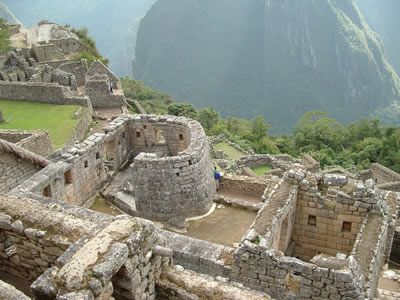The Temple of the Sun
 The Temple of the Sun is located in the urban sector and can be only entered through a large access gate, gate which was provided with double beams and a closure mechanism to provide the city with the necessary means of protection and security. According to anthropological researches, the exact location of the Citadel was chosen to place the city at the highest altitude and, thus, this location in turn get to contemplate heaven more closely. The Inca civilization believed that, a closer position to the Sun would allow a better and more appropriate location for the settlement, as well as for the practice of the different doctrines like astronomical studies.
The Temple of the Sun is located in the urban sector and can be only entered through a large access gate, gate which was provided with double beams and a closure mechanism to provide the city with the necessary means of protection and security. According to anthropological researches, the exact location of the Citadel was chosen to place the city at the highest altitude and, thus, this location in turn get to contemplate heaven more closely. The Inca civilization believed that, a closer position to the Sun would allow a better and more appropriate location for the settlement, as well as for the practice of the different doctrines like astronomical studies.
The most important building for Machu Picchu, the tower known as Torreon, was placed inside of the Temple of the Sun to indicate that that was exactly the position with the highest altitude all over the city. This was therefore, the designated position toplace what could be the citadel’s civic center, the Temple of the Sun, where the most important and meaningful events were held. These events, like astrology, sacred rituals or religious sacrifices, have left behind a large number of archaeological remains, like the gnomic device or sundial that was used for the civilization to indicate the daylight hours and therefore, to create the Inca calendar.
The “Torreon” shows a striking semicircular architectural design; its flat segment holds the Serpent gate while the circular wall has two peculiar trapezoid shaped windows. The tower was built up on the top of a big granite rock that is part of the mountain, taking advantage of its natural outline. It was on this rock where a 10 meters enclosure and half wall were made out of irregular blocks of stone hand-polished. The door used to contain a large number of elaborate encrusted jewels and all kind of golden ornamentation. The proof that, these adornments were part of the decoration of walls and ceilings, has been explained in the large number of empty hollows on all the elements of this complex due to the sack of the city after it was abandoned and also, because of a tragic and ill-fated incident when a fire, that was originated in the surrounding areas, destroyed part of the complex.
Underneath the Tower, there is anentrance that leads to a small underground cavern that shows excellent masonry works.The walls are fully aligned and carved in stone, keeping the theory that this room was a crypt to accommodate the mummified corpses of the highest members of the Inca aristocracy. In the western side of the temple, a rectangular courtyard shows nine hollows that could have been intended as graves.
Another of these adjacent buildings has still a drain and sewage system what shows that this room was once a shed that had used to breed autochthonous species of the Andean fauna, predominantly, domesticated Camelids like Alpacas and Llamas. This byre or animal barn leads to an adjacent room that gives access to another private chamber that has a balcony facing the Eastern of the city and providing a stunning view of the area.